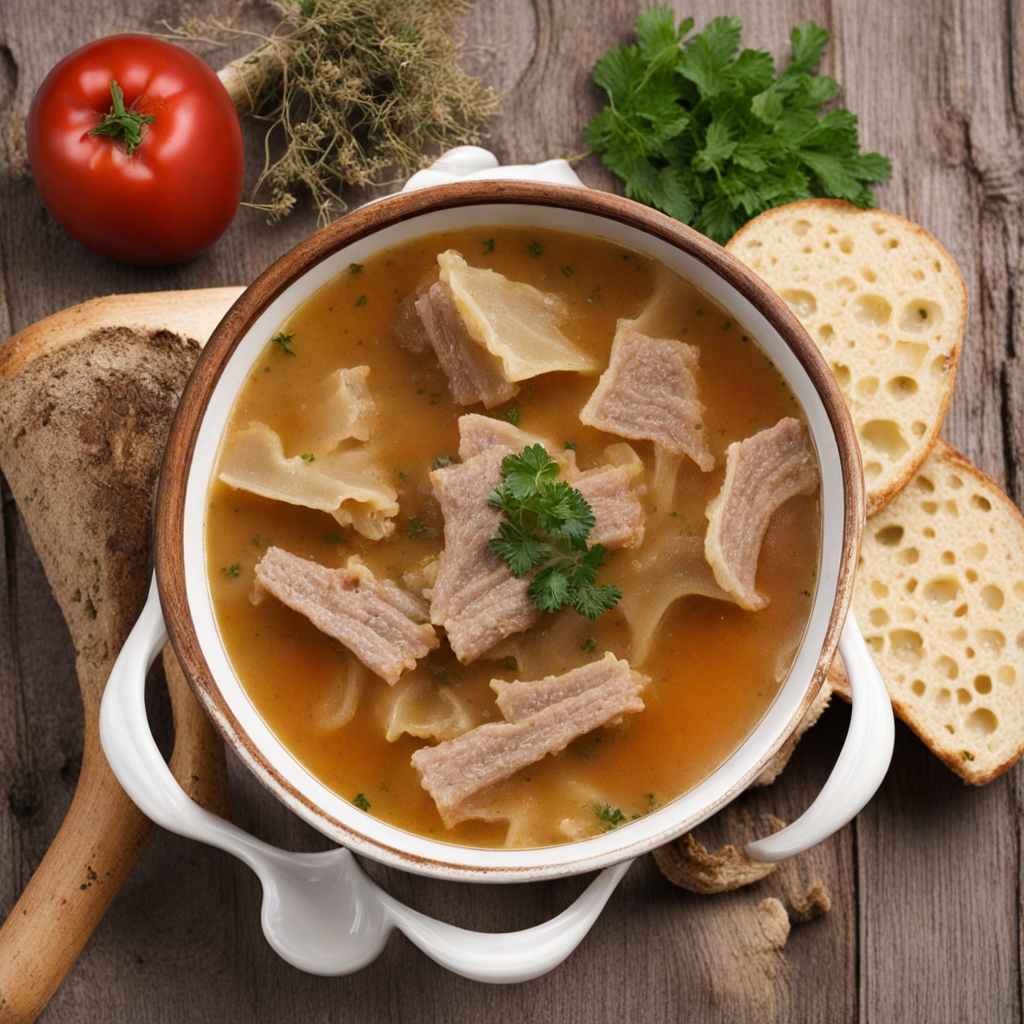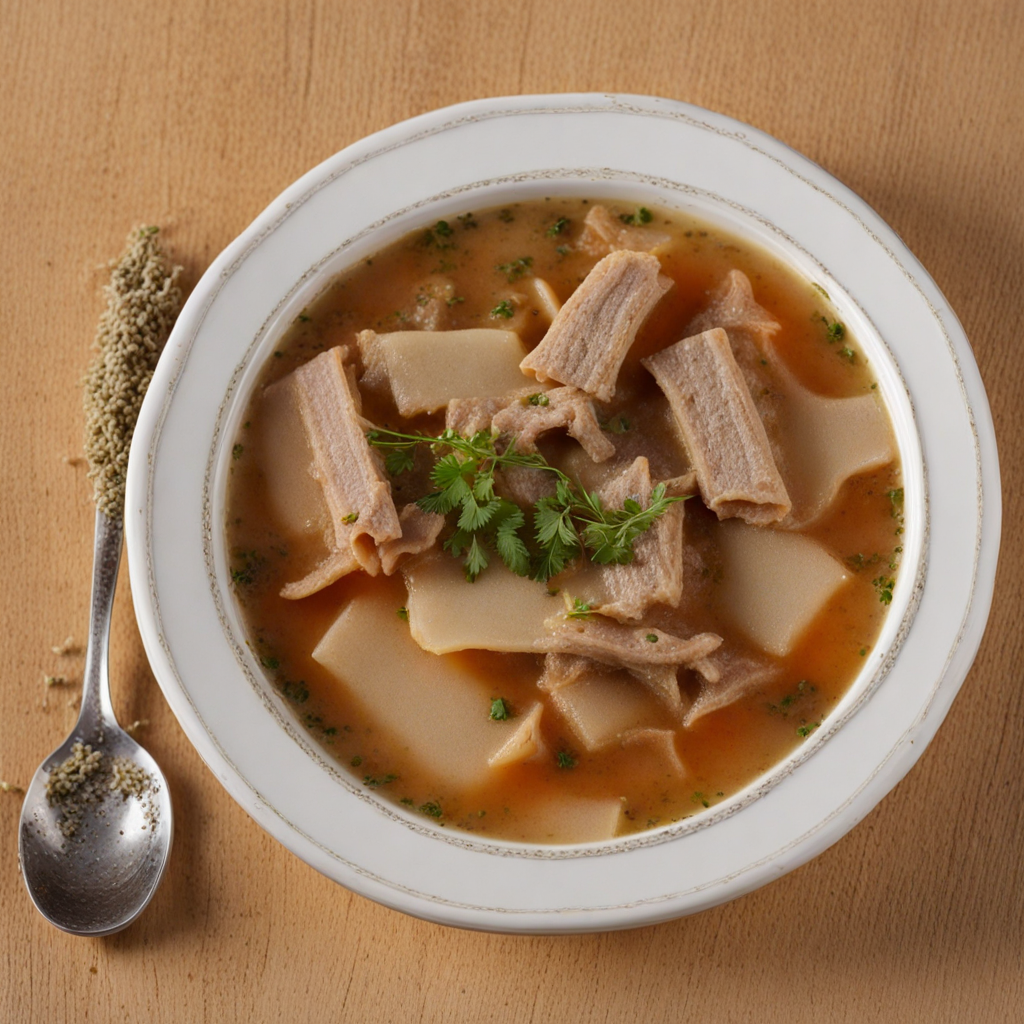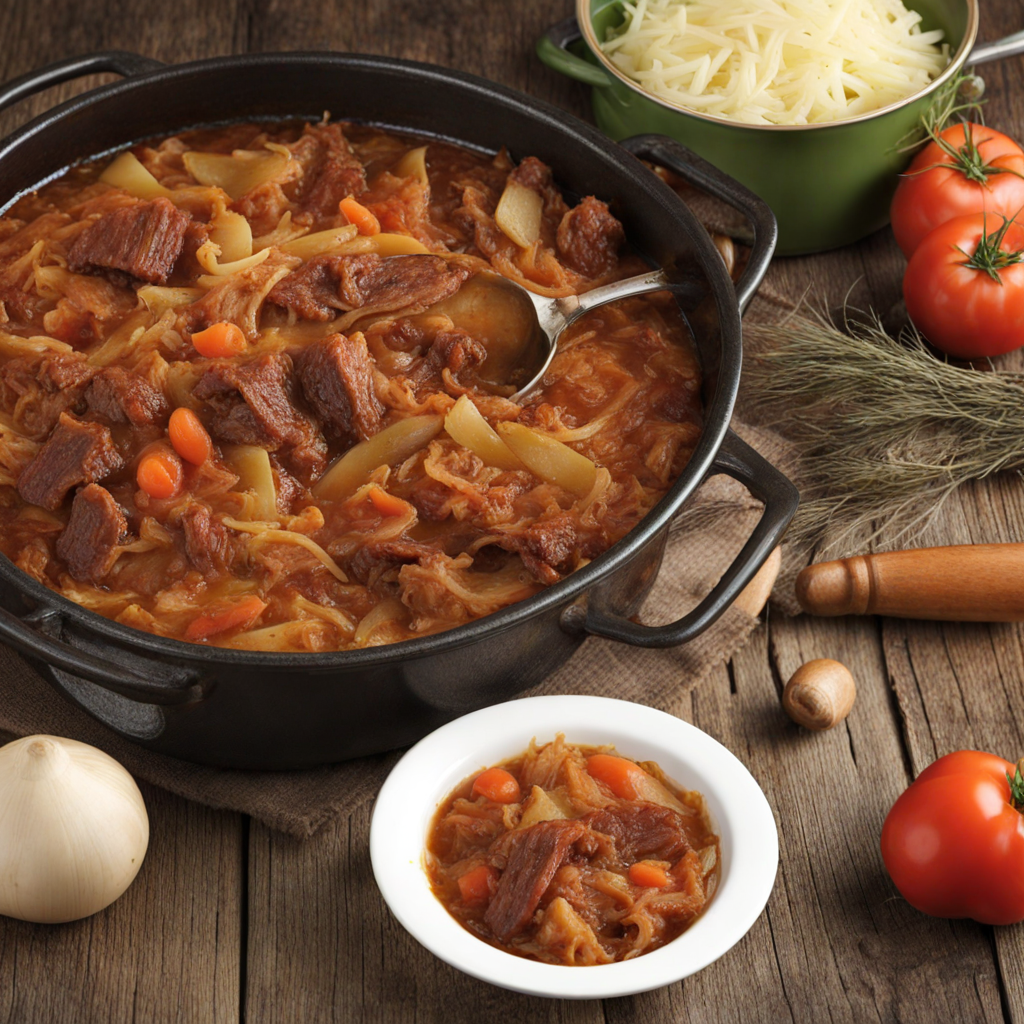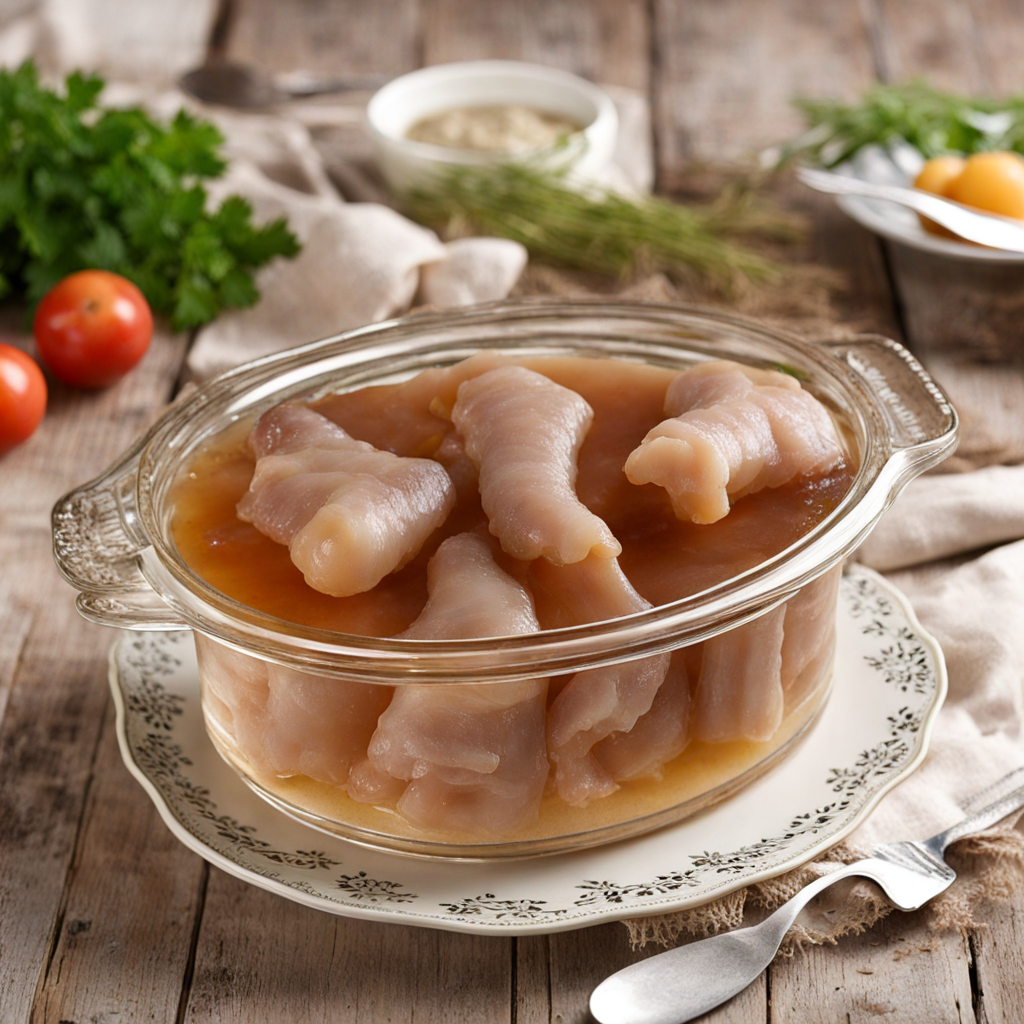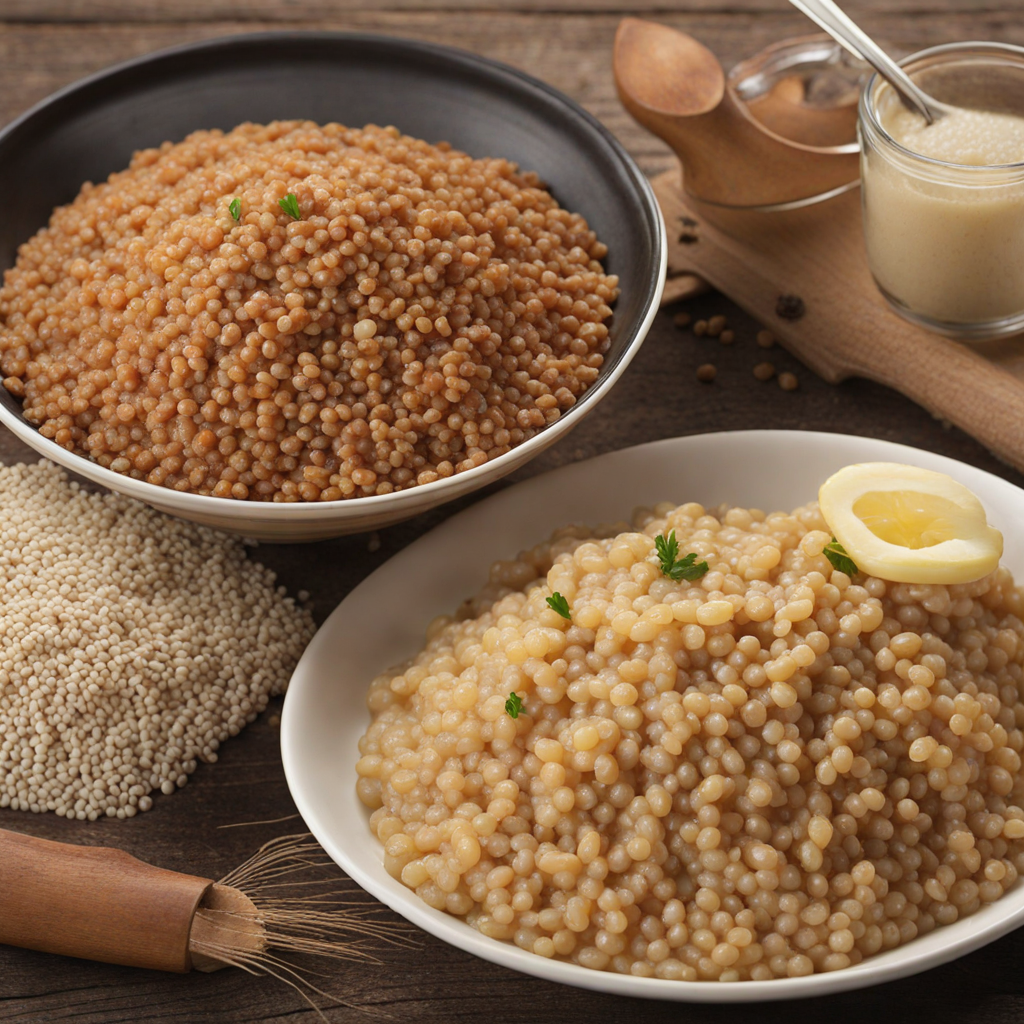Flaki
Flaki, also known as tripe soup, is a traditional Polish dish that offers a unique and hearty culinary experience. This dish primarily features beef tripe, which is the edible lining of the stomach, cut into thin strips and cooked slowly to achieve a tender texture. The tripe is simmered in a flavorful broth made from a blend of spices, including marjoram, bay leaves, and black pepper, along with vegetables such as carrots and celery. The result is a rich, aromatic soup that is both comforting and satisfying, making it a popular choice during the colder months. The preparation of Flaki is an art in itself, often passed down through generations in Polish families. The dish is usually served hot, garnished with fresh parsley or dill, and accompanied by crusty bread or rye rolls that are perfect for dipping. The broth is typically thickened with a roux or sometimes with a dash of sour cream, enhancing its creamy texture and adding depth to the flavor profile. Each bowl of Flaki is a warm hug on a plate, inviting you to savor its complex layers of taste. What sets Flaki apart from other soups is its distinctive texture and robust flavor, which may be an acquired taste for some. The combination of the tender tripe and the well-seasoned broth creates a dish that is both earthy and savory. For those adventurous eaters looking to explore Polish cuisine, Flaki offers a glimpse into the heart of traditional cooking, celebrating the use of every part of the animal and the importance of community and family in the culinary experience. It's a dish that tells a story, where every spoonful brings you closer to the rich heritage of Poland.
How It Became This Dish
Flaki: A Culinary Journey Through Polish History Flaki, also known as tripe soup, is a distinguished dish deeply embedded in Polish culinary tradition. Known for its rich flavor and hearty texture, flaki serves as a testament to Poland's resourceful approach to cooking, especially in times of scarcity. This dish not only satiates the appetite but also tells a story of the nation’s cultural and historical evolution. #### Origins and Cultural Significance The origins of flaki can be traced back to the Middle Ages, a period when animal husbandry was a vital aspect of rural life in Poland. During this time, various parts of the animal were utilized to minimize waste, a practice that was necessary for survival. Tripe, the edible lining from the stomachs of cattle, became a staple among peasants and was often prepared in a variety of ways throughout Europe. Its use in Polish cuisine reflects a broader European trend of using offal, which was prevalent before the rise of modern butchery practices. Flaki is believed to have gained popularity in Poland in the 16th century, coinciding with the nation's growing culinary sophistication. The dish was frequently served at weddings and feasts, a testament to its status as a hearty meal fit for celebrations. The combination of tripe, spices, and broth made it a versatile dish that could be adapted with local flavors, making it a beloved staple across various regions of Poland. Culturally, flaki represents more than just a meal; it is a symbol of Polish resilience and ingenuity. During difficult times, such as the partitions of Poland and World War II, when food scarcity was rampant, traditional dishes like flaki provided nourishment while also preserving cultural identity. The communal aspect of sharing a pot of flaki during family gatherings or festive occasions further solidifies its significance in Polish social customs. #### Ingredients and Preparation Traditional flaki is prepared using beef tripe, typically from the stomachs of cows, which is cleaned thoroughly, boiled, and then sliced into thin strips. The soup is characterized by its rich, savory broth, often made with a base of beef stock, seasoned with a blend of spices such as marjoram, garlic, and pepper. Some recipes include vegetables like carrots and celery, while others may add a hint of heat with chili peppers. The preparation of flaki requires patience and skill, as the tripe must be cooked for several hours to achieve the desired tenderness. This labor-intensive process is a reflection of the values embedded in Polish cooking—taking the time to honor ingredients and create flavors that resonate with tradition. Over the years, regional variations of flaki have emerged, showcasing local ingredients and culinary preferences. For instance, in Kraków, flaki may be enriched with a touch of cream, while in Warsaw, it may be served with a side of sour rye bread. These variations highlight the adaptability of flaki, as it has evolved to suit the palates of different communities while maintaining its core identity. #### The Evolution of Flaki Over Time The 19th and early 20th centuries saw a renewed interest in Polish cuisine, as chefs began to explore and document traditional recipes. This period marked a significant transformation in the way flaki was perceived. No longer just a humble peasant dish, it began to appear in fashionable restaurants, showcasing the culinary heritage of Poland to a broader audience. Cookbooks from this era often included flaki, emphasizing its importance in Polish gastronomy. However, the tumultuous events of the 20th century, including World War I, World War II, and the subsequent Communist regime, had profound effects on Polish food culture. During these challenging times, many traditional recipes, including flaki, adapted to the constraints of available ingredients. The post-war period saw a shift in the presentation of flaki, transforming it into a dish that could be easily mass-produced yet still retained its comforting essence. In contemporary Poland, flaki remains a cherished dish, often found on the menus of traditional Polish restaurants and during festive occasions. It is frequently served at Christmas Eve dinner as a way to honor the past while celebrating the present. The soup's warmth and heartiness resonate with the spirit of Polish hospitality, making it a popular offering for guests and family alike. Moreover, flaki has found its way into the culinary consciousness beyond Poland’s borders, as Polish immigrants and their descendants have introduced the dish to new communities. In cities with significant Polish populations, such as Chicago and London, flaki has become a beloved comfort food, bridging cultural gaps through the universal language of food. #### Flaki in Modern Culinary Trends In recent years, the global food movement has prompted a resurgence of interest in traditional and regional dishes. Chefs around the world are embracing nose-to-tail cooking, a philosophy that aligns perfectly with the origins of flaki. This renewed appreciation for offal has led to a renaissance of dishes like flaki, encouraging both culinary experimentation and a deeper understanding of sustainable eating practices. As food enthusiasts seek authentic experiences, flaki has found a place not only in traditional Polish restaurants but also in modern culinary spaces that celebrate heritage cooking. Contemporary interpretations often incorporate innovative techniques, such as sous-vide cooking or artisanal broths, while still honoring the essence of the original recipe. #### Conclusion Flaki is more than just a soup; it embodies the history, culture, and resilience of the Polish people. From its origins as a humble peasant dish to its status as a beloved staple in contemporary Polish cuisine, flaki has undergone significant transformation while remaining a cherished part of Poland’s culinary heritage. It serves as a reminder of the importance of resourcefulness in cooking and the power of food to connect generations. As flaki continues to evolve, it stands as a delicious tribute to Poland's rich history and a beacon of cultural identity, inviting both locals and visitors to partake in its warm, hearty embrace. Whether enjoyed in a cozy kitchen or a bustling restaurant, flaki remains a dish that nourishes not only the body but also the soul, bridging the past with the present and celebrating the enduring spirit of Polish cuisine.
You may like
Discover local flavors from Poland


